
Become a Data-Driven Learning Enterprise
A Guide to Data-Driven Decision Making and Organizational Learning

The Illusion of Data-Driven Operations
Ask any executive, and they will say, “We’re a data-driven organization.” They will proudly mention their BI tools, CRM systems, and perfectly managed Excel sheets. However, if one looks beyond these indicators of data-savvy, a different picture can be seen.
The truth? Most businesses and organizations are overwhelmed by the vast volumes of data they procure while they lack the insights they need. Each of your teams loses a lot of productive time digging through disparate systems, arguing over cells in conflicting spreadsheets, and wondering which of those sheets is accurate. Your analysts spend hundreds of working hours at document mining and checking – time that can be better spent on analysis. Meanwhile, your decision-makers are left wondering: Is this dashboard showing the same KPIs as the quarterly report? Which sales forecast should I trust? Where is the source data for this metric?
This has become a problematic area for nearly every business. Every business is always-on, constantly collecting data making the gap between having data and effectively using it isn’t just wide; it’s widening. While your organization may be collecting data, the crucial questions remain: Are all the KPIs available at the fingertips of each decision-maker? Do you and your team know who holds the single source of truth on your data? Do they know where it came from when they have a metric? If you’re hesitating on any of these questions, you aren’t the only one, and it might mean you aren’t data-driven.
Getting to real-time operations isn’t a quest for more dashboards or data sources. It addresses the raw fundamentals of data discoverability, quality, and management. As long as an organization cannot do all of this seamlessly and at a required pace, your organization is still data-enabled, not data-intensive.
In this whitepaper, we will cover the following topics:
- The Essence of a Learning Organization: How it stands apart from traditional organizational models.
- The Compelling Benefits: Why transforming into a learning organization is critical for your business's future.
- Blueprint for Transformation: Practical strategies to construct a robust learning organization using data-driven tools and methodologies.
Continue reading
Fill out the form to continue reading
What is a Learning Organization?
A learning organization develops and applies knowledge to improve and adapt based on new insights. It’s an organization that continually learns from data and uses what it knows to improve itself.
A learning organization has the following characteristics:
- A clear, data-driven vision and mission that guides all actions and decisions
- A culture of data literacy and curiosity where everyone can access, understand, and leverage data
- A culture of experimentation and innovation, where hypotheses are tested and learnings are applied
- A culture of feedback and reflection, where insights and challenges are openly shared
- A culture of collaboration and alignment, where teams work in sync towards common goals
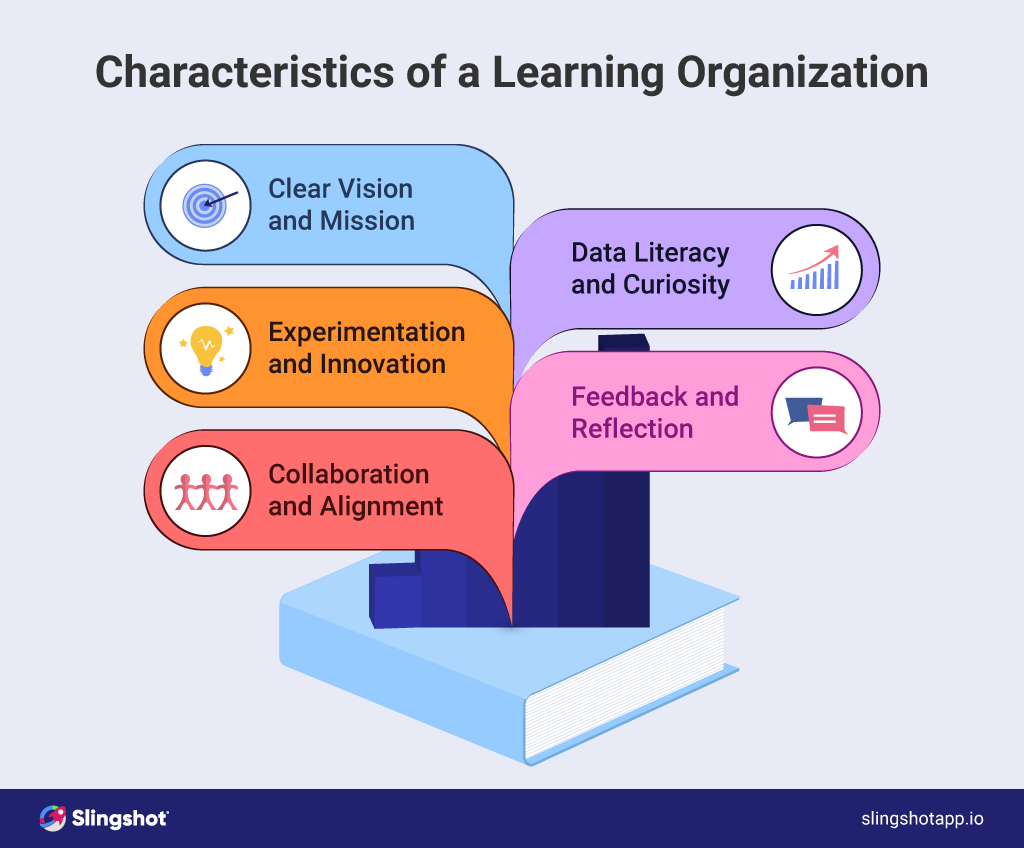
Learning organizations differ from traditional organizational models, which are often hierarchical, rigid, and reliant on intuition or authority for decision-making. Learning organizations are agile, flexible, and data-driven, viewing changes as opportunities and failures as valuable learning experiences.
Data and continuous learning are crucial in shaping a learning organization; they are the fuel that powers it and provide the information and insights that inform its actions and decisions. Continuous learning is the engine that drives a learning organization, enabling it to constantly acquire new knowledge and skills and apply them to improve its performance and adapt to changes.
Top 3 Business Benefits of Becoming a Learning Organization
As a C-level executive, you’re responsible for steering your organization toward sustainable growth and competitive advantage. Here are 3 top benefits of building a learning organization:
- Enhanced Agility: Rapid adaptability is crucial in today’s volatile business landscape. With a strong foundation in data-driven insights, your organization can swiftly pivot in response to market shifts, regulatory changes, and other challenges. Leverage predictive analytics to anticipate future trends and get ahead of the competition.
- Elevated Employee Engagement: Empowered, motivated teams are the lifeblood of any successful business. You’ll foster a culture of ownership, responsibility, and accountability by involving employees in data-driven decision-making. This collaborative approach fuels innovation and aligns your workforce towards shared goals.
- Sustained Innovation: The most innovative organizations continuously learn, experiment, and apply data-driven breakthroughs. Encourage your people to challenge conventions, test hypotheses, and translate insights into game-changing solutions. This iterative cycle of learning keeps you at the forefront of your industry.
By embracing the principles of a learning organization, you can unlock unparalleled agility, engagement, and innovation – the cornerstones of long-term success in today’s dynamic business environment.
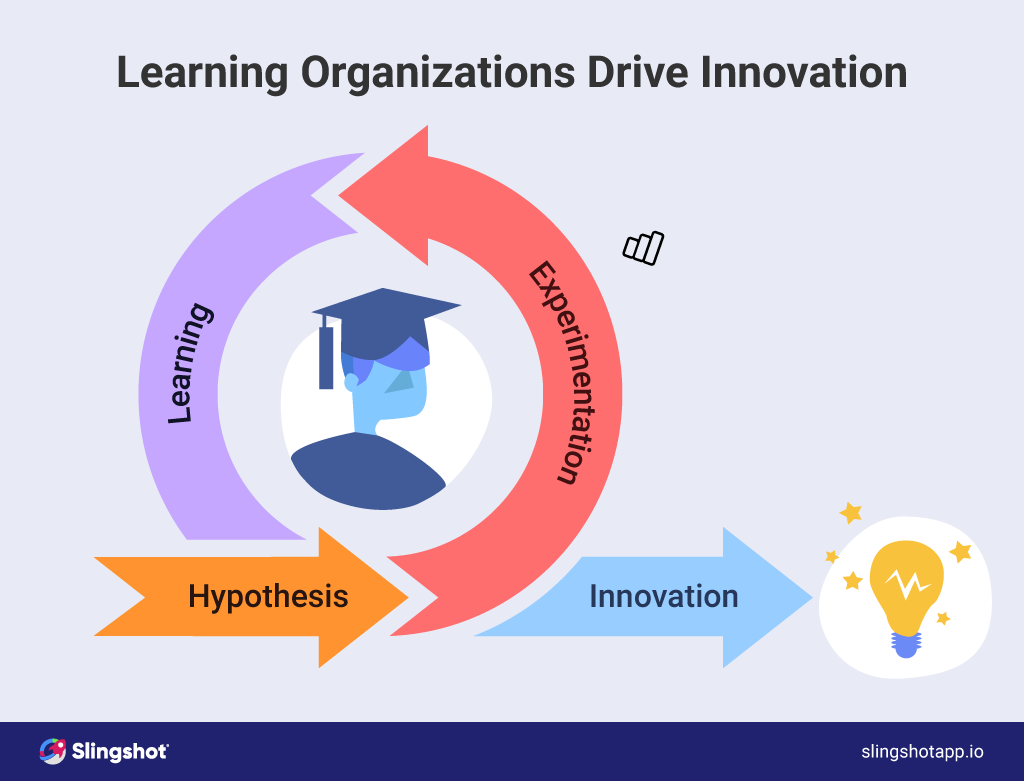
Why Become a Learning Organization?
In a time where change is the only constant, the ability to continuously evolve and adapt is no longer just a competitive advantage—it’s necessary for survival and continued success. Transforming your organization into a learning organization goes beyond ordinary change to fundamentally reshape how a company operates and competes in today’s digital marketplace. Being a data-driven business provides you with critical strategic advantages in several areas:
- Competitive Advantage: Leverage data as the new “currency” to anticipate trends, capitalize on opportunities, and respond swiftly to threats.
- Employee Retention and Satisfaction: Foster a resilient, adaptable workforce motivated by their ability to contribute to your organization’s progress.
- Sustained Innovation: Empower employees to generate and test hypotheses, driving a constant flow of new ideas, products, and services.
- Long-Term Viability: Use data to monitor, manage, and improve your organization’s environmental and social impact, solidifying stakeholder trust and loyalty.
- Organizational Resilience: Develop a culture that transforms disruptions into opportunities for growth, preparing your organization to thrive.
4 Practical Steps to Build a Learning Organization
Transforming into a data-driven enterprise requires a strategic, multi-phased approach. You can rethink and reshape your organizational practices to be more adaptive, innovative, and sustainable. Here is a four-step, practical roadmap to embed continuous learning into your culture and operations:
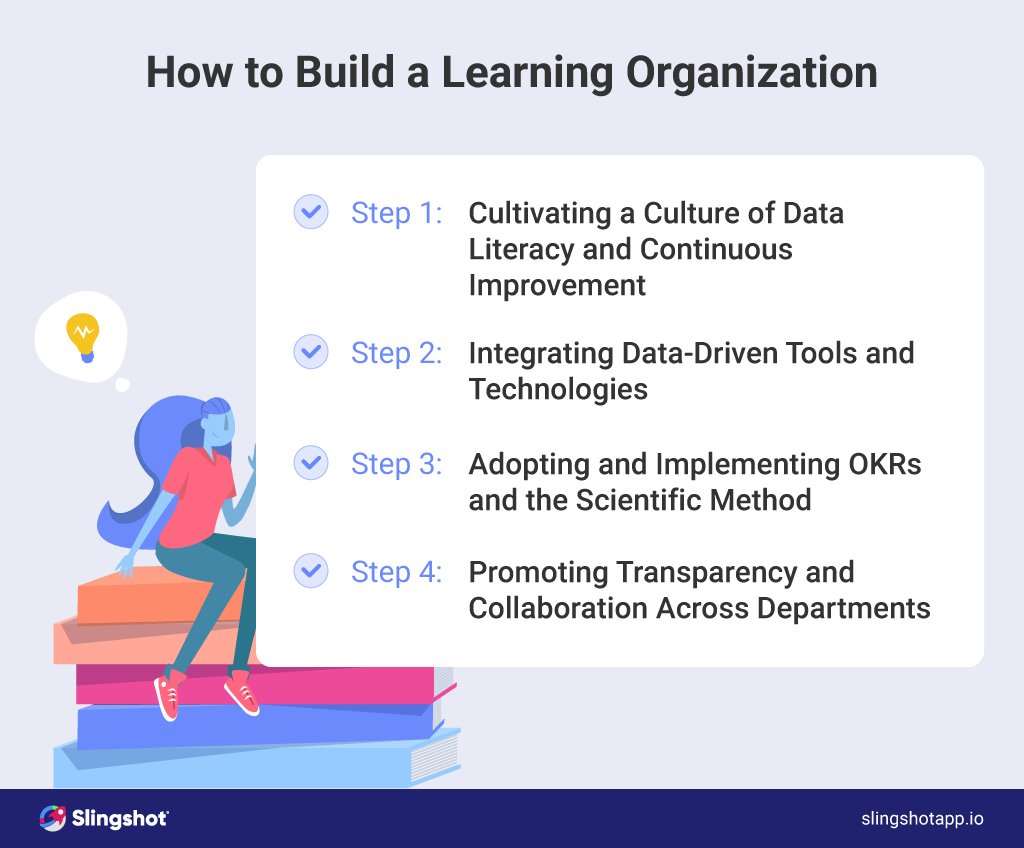
Step 1: Cultivating a Culture of Data Literacy and Continuous Improvement
Data literacy is essential for making informed decisions and fostering an environment where every employee can contribute to innovation and process enhancement. This improves operational efficiency and empowers employees, boosting morale and retention.
- Develop and Deploy a Data Literacy Curriculum: Create comprehensive training programs tailored to different organizational roles, ensuring all employees understand how to interpret and use data effectively.
- Establish a Continuous Learning Platform: Utilize e-learning systems that offer courses on new technologies, market trends, and analytical skills.
- Recognize and Reward Innovation: Implement a rewards system that acknowledges and promotes innovative uses of data and continuous improvement efforts among teams.
Step 2: Integrating Data-Driven Tools and Technologies
The right tools can streamline data access and analysis, making it easier to uncover actionable insights. This integration supports a proactive approach to business management, allowing organizations to anticipate market changes and react swiftly.
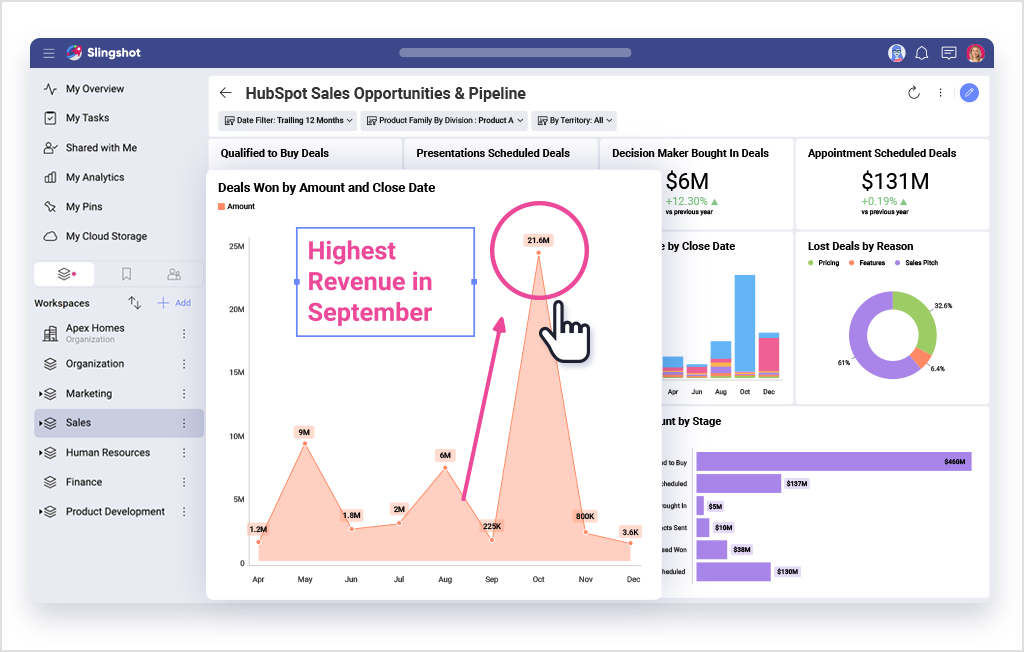
- Assess and Upgrade Technology Infrastructure: Conduct a technology audit to identify needs and integrate advanced data analytics tools that enhance data accessibility and insight generation.
- Facilitate Seamless Data Access: Ensure employees at all levels access relevant data through user-friendly interfaces.
- Promote Tool Adoption through Training: Provide ongoing training to ensure that all employees can effectively utilize new technologies for data analysis.
- Tools like Slingshot: Implement platforms that integrate data seamlessly and provide actionable insights through analytics and reporting.
- Advanced Analytics and AI: Use artificial intelligence to predict trends, automate tasks, and make informed decisions quickly.
Step 3: Adopting and Implementing OKRs and the Scientific Method
OKRs help clarify business goals and provide measurable ways to track progress, aligning individual performance with company objectives. The scientific method promotes a structured approach to experimentation and problem-solving, critical for innovation and continuous improvement.
- Define and Communicate OKRs: Clearly articulate the company’s objectives and expected key results. Ensure alignment across all departments.
- Train on the Scientific Method: Organize workshops to teach employees how to formulate hypotheses, design experiments, and analyze data.
- Regularly Review Progress: Hold quarterly reviews to assess the progress of OKRs and ongoing projects, adapting strategies as needed based on empirical data and analysis.
Step 4: Promoting Transparency and Collaboration Across Departments
Transparency builds trust and accountability, while collaboration breaks down silos and leverages diverse perspectives for better decision-making. Inclusive environments increase employee engagement and commitment to organizational goals.
- Implement Cross-Departmental Initiatives: Encourage projects requiring multiple departments’ input, promoting a collaborative culture.
- Enhance Communication Channels: Use technology to create open channels where employees can share insights, ask questions, and provide feedback.
- Involve Employees in Decision Processes: Develop frameworks that include employees in decision-making, such as collaborative platforms and regular strategy meetings.
Conclusion: Unlock Your Organization’s Potential with Slingshot
Transforming into a learning organization is not merely an option but a necessity. Using the principles outlined in this white paper, you can create an environment where data literacy, innovative thinking, and collaborative problem-solving are at the core of your organizational culture.
However, turning theory into practice can be complex. This is where Slingshot, a comprehensive data-driven work management platform designed for the modern enterprise, can be a valuable partner. Slingshot embodies the principles of a learning organization, seamlessly integrating data analytics, project management, and collaboration tools into a single, intuitive platform that empowers your teams across the enterprise to make data-driven decisions and adapt continuously to their changing environments.
With Slingshot, you can:
- Centralize data for unprecedented accessibility and transparency
- Streamline communication and collaboration across departments
- Enhance project execution and outcomes with data-driven insights
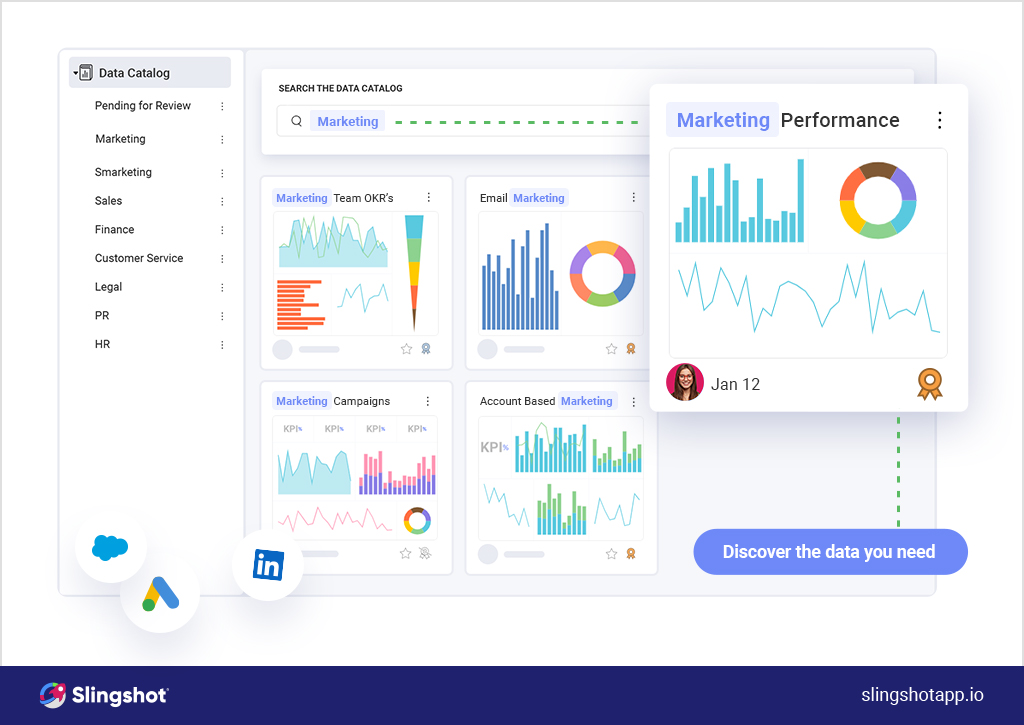
Contact us today to see how Slingshot can help your organization thrive with data-driven decision-making.
Use Slingshot To Help Your Business
See how Slingshot can help you and your teams do more of their best work.





